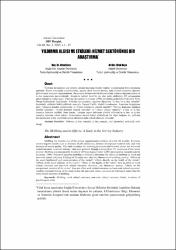| dc.contributor.author | Avcı, Umut | |
| dc.contributor.author | Kaya, Ufuk | |
| dc.date.accessioned | 2020-11-20T17:52:04Z | |
| dc.date.available | 2020-11-20T17:52:04Z | |
| dc.date.issued | 2013 | |
| dc.identifier.issn | 0378-2921 | |
| dc.identifier.issn | 1309-1034 | |
| dc.identifier.uri | https://app.trdizin.gov.tr//makale/TVRVNU1EWTFOUT09 | |
| dc.identifier.uri | https://hdl.handle.net/20.500.12809/8859 | |
| dc.description.abstract | Yıldırma davranışları son yıllarda çalışma hayatının önemli örgütsel sorunlarından birisi durumuna gelmiştir. Bunun sonucunda iş tatminsizliği, işgören devir hızının artması, hatta hizmet kalitesinin düşmesi gibi olumsuz sonuçları doğurmaktadır. Bu çalışma, hizmet sektörü işletmelerinde yıldırma algısının iş başı ve iş dışı sonuçlarını incelemektedir. Araştırma verileri İzmir’de yer alan şehir otellerinin 235 çalışanından anket tekniğiyle toplanmıştır. Yıldırma davranışları Leymann (1996) tarafından geliştirilen Psikolojik Terör Ölçeği kullanılarak ölçülmüştür. Yıldırma davranışlarını algılama düzeyinin “iş başı ve iş dışı sonuçlar” üzerindeki etkilerini belirleyebilmek amacıyla Yapısal Eşitlik Modeli kurulmuştur. Araştırma bulgularına göre, “çalışanın kendini göstermesine ve iletişim kurmasına yönelik engeller”, “bireyin doğrudan sağlığına yönelik saldırılar”, “sosyal ilişkilere yönelik saldırılar” ve “itibara yönelik saldırılar” iş başı ve iş dışı sonuçlar üzerinde etkilidir. Buna karşın, “çalışma yaşam kalitesine yönelik saldırılar”ın iş başı ve iş dışı sonuçlar üzerinde etkisi yoktur. Araştırmanın önemli kabul edilebilecek bir diğer bulgusu da, yıldırma davranışlarının iş dışı etkilerinin iş başı etkilerden daha yüksek düzeyde olmasıdır. | en_US |
| dc.description.abstract | Mobbing has become one of the critical organizational problems of work life recently. It creates several negative results such as decrease of job satisfaction, increase of employee turnover rate, and even decrease of service quality. This study examines the mobbing perceptions and its work related and non-work related outcomes in service industry. Data were gathered through a survey from 235 employees of city hotels in Izmir. Mobbing was measured by Inventory of Psychological Terror (LIPT) developed as research scale by Leymann (1996). Structural equation modeling is utilized to determine the effects of mobbing on work and non-work related outcomes. Findings of the study show that four dimensions of mobbing, namely, & #8220; effects on the assert him/herself and communication of the victim& #8221; ; & #8220; effects directly on the health of the victim& #8221; ; & #8220; effects on the social relations of the victim& #8221; ; & #8220; effects on the dignity of the victim& #8221; , have an effect on work related outcomes and non-work related outcomes. However, one dimension, namely, & #8220; effects on the occupational situation of the victim& #8221; does not affect work related outcomes and non-work related outcomes. Another important finding of this study is that, the non-work related outcomes of mobbing is higher than the work related outcomes of mobbing. | en_US |
| dc.item-language.iso | tur | en_US |
| dc.item-rights | info:eu-repo/semantics/openAccess | en_US |
| dc.subject | Uluslararası İlişkiler | en_US |
| dc.subject | Siyasi Bilimler | en_US |
| dc.title | Yıldırma algısı ve etkileri: Hizmet sektöründe bir araştırma | en_US |
| dc.item-title.alternative | The mobbing and its effects: A study in the service industry | en_US |
| dc.item-type | article | en_US |
| dc.contributor.department | MÜ, Turizm Fakültesi, Turizm İşletmeciliği Bölümü | en_US |
| dc.contributor.institutionauthor | Avcı, Umut | en_US |
| dc.identifier.volume | 68 | en_US |
| dc.identifier.issue | 2 | en_US |
| dc.identifier.startpage | 1 | en_US |
| dc.identifier.endpage | 25 | en_US |
| dc.relation.journal | Ankara Üniversitesi SBF Dergisi | en_US |
| dc.relation.publicationcategory | Makale - Ulusal Hakemli Dergi - Kurum Öğretim Eleman | en_US |


















